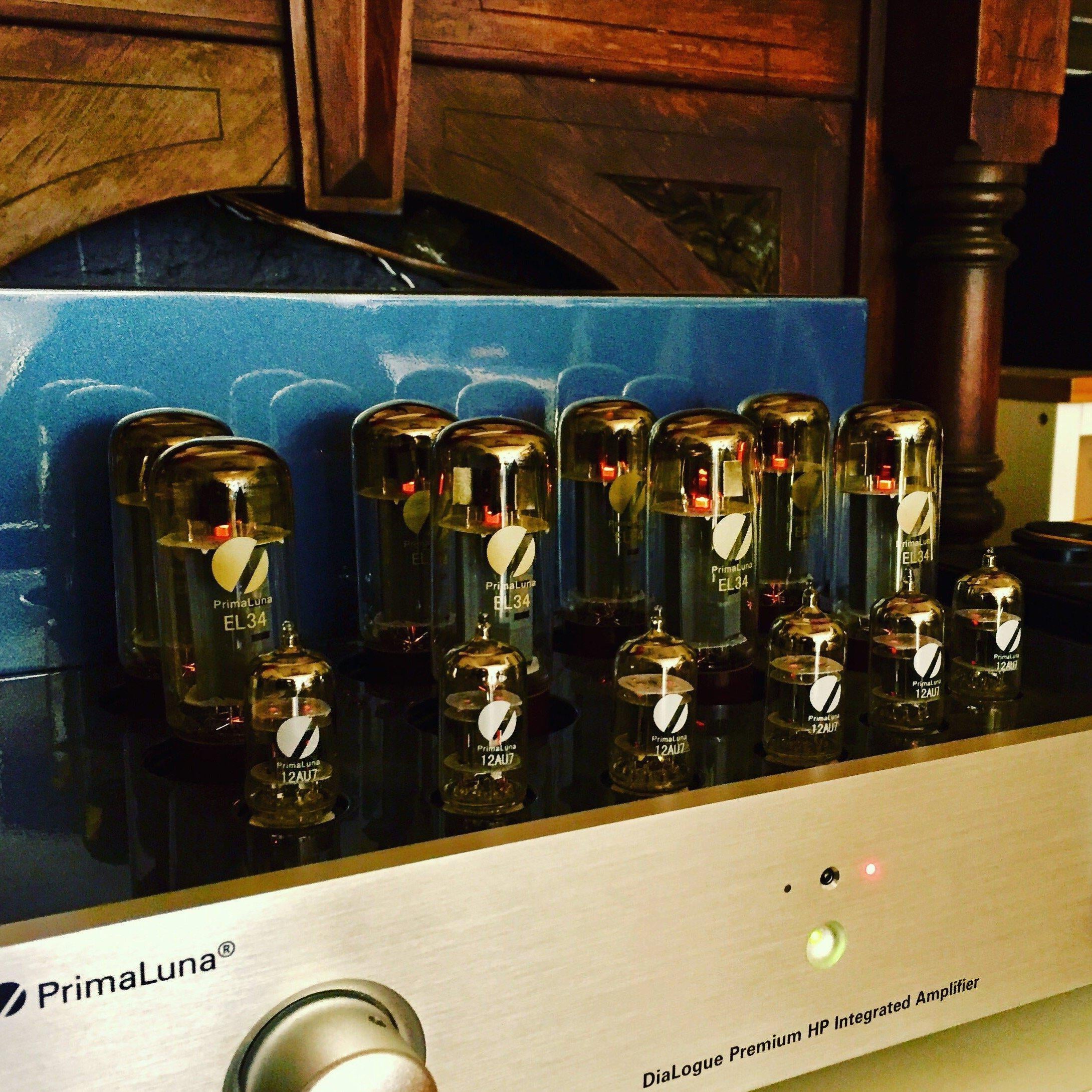
With PrimaLuna releasing their new EVO range of Valve audio products it is time to talk PrimaLuna. PrimaLuna is a company based in The Netherlands that specialises in designing and manufacturing valve amplifiers. It has been nearly a decade since PrimaLuna has introduced an entirely refreshed product line of valve amplifiers and you will find the new EVO series shares the previous line’s DNA. The new products feature upgraded transformers and internal components, improved aesthetics and an enhanced features set including true-balanced, transformer-coupled XLR inputs and outputs on upper-end models. Just as importantly is what hasn’t changed, including the meticulous hand-assembly, point-to-point wiring, superlative build quality and cutting-edge Adaptive Auto-Bias (TM) circuitry upon which PrimaLuna has built its reputation.

PrimaLuna have evolved the classic valve sweetness of the iconic Marantz 1960's Model 7 and 8 valve amplifiers to incorporate modern technology designs and presented them in a beautiful classic aesthetic. The Marantz valve amplifiers were revered for their sonic warmth and are exceptionally collectible today. They sell for many $1000's when they come up for resale. They did suffer from the shortcomings in valve technology at the time. Valve reliability was quite poor and they failed regularly due to the inability of the amplifier designs to minimise dissipation per tube resulting in sonic degradation as the tubes wear out and have to be replaced. PrimaLuna was founded on the idea of eliminating tube maintenance. They do this by using a true and sophisticated Adaptive AutoBias system while running tubes at the minimum dissipation (power). PrimaLuna on their website state: "Our tubes last longer than Keith Richards!"
PrimaLuna run their tubes at the minimum dissipation per tube possible without going into crossover distortion. Forget replacement costs because it will happen rarely. If one of the power output tubes wears “uneven” compared to its workmates, Adaptive AutoBias will work hard to ensure you never know it by allowing suboptimal tubes to sound their best. The result is customers have gone as long as ten years of regular use on one set of tubes!

The other drawback of the original valve amplifier designs compared to the then newly introduced Solid State amplifier designs was their lack of "Bass Slam" which was becoming particularly important with Rock and Pop music requiring more punch from amplifier designs to reproduce the evolving bass lines. PrimaLuna resolved this particular problem by giving more slam and bandwidth through superior output transformer design. Unfortunately, power means nothing when it comes to sound quality, dynamics, and bass slam. An amp can have 200 watts per channel, but if it doesn’t have output transformers with enough bandwidth, the speakers won’t receive it. PrimaLuna is one of only a few manufacturers in the world that actually designs and winds our power and output transformers in-house. Their engineering is performed by two top tier designers, one in The Netherlands and one in the United States. No expense is spared. That is why products that cost twice as much will never sound as good as a PrimaLuna.
PrimaLuna's Holland-based CEO-designer, Herman van den Dungen, apparently believes that the sonic quality of all audio amplification is set mainly by the physical and electrical characteristics of its power supply, and that expensive, overspecified, choke-filtered, tube-rectified supplies make music sound more natural and easy-flowing than do silicon diodes and cheap chip voltage regulators. It is a fact that tube rectifiers are quieter and less colored than silicon diodes. Hence PrimaLuna incorporate these power supply designs into their range of valve amplifiers.

Auto Adaptive Bias
PrimaLuna's Adaptive AutoBias is a true, smart technology. It employs an array of sensors to monitor tubes and make adjustments seamlessly in real time. Adaptive AutoBias is completely passive and NOT in the signal path. The result is low to no maintenance, long tube life, and the lowest possible distortion for amazing sound.
Adaptive AutoBias is passive: It is NOT in the signal path. Period. There are only benefits in tube life and improved sound.
The audible advantages of the Adaptive AutoBias were far greater than PrimaLuna had anticipated. They foresaw a slight improvement in power efficiency and distortion levels, but the gains exceeded their expectations. Transparency over the entire frequency spectrum improved significantly, even in the bass region where qualities such as power, authority and control surpassed what we heard in amplifiers of much greater power. The amplifier sounds quicker and more responsive but with unexpected power reserves far beyond its rating.
Distortion levels plummeted fifty percent, adding incredible authenticity to vocals and instruments and eliminating harshness when the amp was pushed hard. Tube aging and tube replacing are no longer factors requiring tweaks and adjustments; overall, tube life is increased and the number of tube failures dropped significantly.
PrimaLuna has a better way. Instead of a switch, input selection is done using premium quality sealed relays mounted in the rear where you plug in your components. When an input is selected, that relay closes giving you the best connection possible. All the other relays are left open, so noise and signals from other sources can’t leak in. The signal path is now almost non-existent, so there are no wires to pick up noise.

Point to Point Wiring
PrimaLuna employs Point to Point Wiring on all products. The entire signal path, including resistors and capacitors, is painstakingly hand wired with heavy-gauge cable by craftsman. Products from the 1960’s like the Marantz 9 power amps, 7C preamp, and all the others that have skyrocketed in value and collectability have something in common: Point to point wiring. The entire signal path, including resistors and capacitors, is painstakingly hand-wired with heavy gauge cable by craftsmen. The higher spec EVO 300 and EVO 400 models use Swiss-made, silver-plated, oxygen-free continuous crystal (OCC) copper with a Teflon dielectric in the critical signal path for superior signal speed and increased clarity.
Other PrimaLuna Performance Upgrades
DuRoch Tinfoil Capacitors
Premium tinfoil capacitors made to our specifications are used in the critical signal paths. These are very expensive but the sonic results speak for themselves.
Takman Resistors
If you bought a lesser amplifier, you would pay hundreds to make this upgrade. Easy to identify through their pink color, these premium resistors from Japan are popular with those who rebuild and upgrade their gear. "Modders" love TAKMAN for their low noise, linearity, and musicality.
AC Offset Killer - A PrimaLuna Exclusive
AC Offset Killer is about goose bumps. The ones you get when music comes out of a background so quiet, you may say to yourself “Just how is this possible?”
PrimaLuna custom-winds their own massive toroidal power transformers that are low in hum and EMI. But they wanted more. Their engineers designed the AC Offset Killer to lower transformer noise to a place no other manufacturer dreams of going, regardless of how bad your electricity is. The result? Sense of space. Texture. The resonance of an acoustic guitar or violin string that seems to trail on forever. The AC Offset Killer will amaze you.
The EVO300 and EVO400 models have Triode/ UltraLinear switching.
We have included a PrimaLuna video that accurately describes the benefits.
Why PrimaLuna?
Since 2003, PrimaLuna has created tube amplifiers with a unique construction found nowhere else. Their technologies bring you closer to the music at a price you won't believe. PrimaLuna has pioneered numerous technologies to redefine tube amplification. From increased reliability and tube life all the way to their unique, signature sound.

We highly recommend you watch this Youtube video that explains further why PrimaLuna valve amplifiers can take you to a magical space in your music listening.


Share:
The Elac Debut Speakers - Andrew Jones Success Story
The Elac Debut Speakers - Andrew Jones Success Story